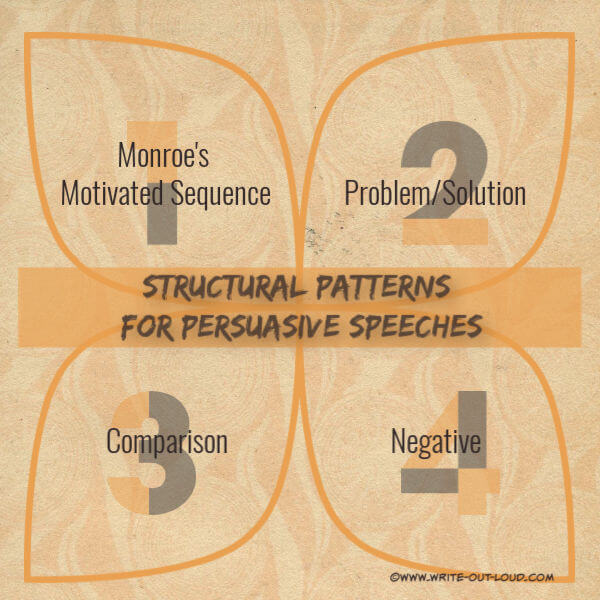According to Your Textbook, Using Evidence in a Persuasive Speech Can
- HOME ›
- How to write a persuasive speech
Writing a persuasive speech
By: Susan Dugdale | Terminal modified: 05-04-2021
Getting started with a 7 betoken action programme
To help y'all through the process of writing a persuasive oral communication from commencement to terminate, here's a 7 step checklist.
To get the near from it move through it sequentially - point by signal. You lot'll notice links to topic proposition pages, explanations about how to construction your speech and the importance of audience assay with examples and more.
In my experience, a successful persuasive speech can't be flicked out in v minutes! There may be brilliantly competent speakers who can exercise it if they know their subject, and their audience within out. However the rest of us, me included, take to put the fourth dimension in to achieve what nosotros desire to. ☺
Quick links to get around this page hands
Checklist for writing a persuasive speech
ane. Selecting a persuasive spoken language topic
If you've already got a speech communication topic move on to setting a goal. For those who don't, read on.
A major part of the challenge of writing a persuasive speech can be choosing what to speak about.
If you're preparing the speech as part of a class exercise or for a public speaking club like Toastmasters you take seemingly unlimited pick. And that tin exist bewildering! The possibilities are vast. How do you narrow them down?
The reply is to choose something that you genuinely care most, fits the occasion AND that you lot know your audience volition be interested in.
2. Setting a goal
The goal of writing a persuasive spoken language is to change or move the audience toward accepting your position on the topic. An essential part of that is knowing exactly what information technology is y'all desire to achieve.
There are degrees of alter. Do you desire a little, or a lot?
Nearly wanted response or MWR
What you lot decide is called yourmost wanted response or MWR.
A realistic MWR is reached through analysis of your audition in relation to your topic.
Example: My topic is "obesity in children".
Audience - who are they?
I am speaking to mothers whose children all nourish the aforementioned kindergarten.
The staff are concerned nearly the number of children who are over weight for their historic period.
The children mostly come from homes where both parents work.

Electric current food habits every bit reported by kindergarten staff
Food is bought already made upward for a diversity of reasons including time saving, convenience, and a lack of knowledge about how to prepare it whatever other mode.
'Treat' food (sweets, cake etc.) is likewise used to pacify and/or to reinforce good behavior.
Fussy or picky eating is allowed principally because the try and time required to change already established patterns is difficult to find.
The problem is compounded by lack of do.
Virtually Wanted Response (MWR) options
In setting the goal (MWR) for the speech I demand to decide what arroyo will reach the best results.
Practice I desire to influence the mothers to open their minds to the thought that allowing a kid to constitute habitual unhealthy eating patterns is detrimental to their children's growth and development?
Or do I want them to end using treat and pre-prepared foods immediately and just offer home cooked salubrious options instead?
The first approach is softly-softly. The second is direct or difficult striking.
3. Audition analysis
Who is your audition?
How you persuade, and your MWR (goal) is near effectively established when y'all sympathize who yous are talking to.
In relation to the topic you're going to speak virtually are they:
- Hostile - actively don't want to hear what y'all have to say for many reasons which may include prejudice, fear, ignorance, inertia, cultural difference, differing values/beliefs ...
- Neutral - no decided opinion or behavior and therefore no investment toward maintaining the current state or moving toward a new one. This is the middle ground.
- Motivated - actively seeking to modify. These people are already enlightened of the 'problem' and are looking for solutions. They want to hear what you have to tell them and are likely to be ready to be convinced of the rightness of your solution.
What else do you demand to know?
Bated from their anticipated baseline attitude, (hostile, neutral, motivated), toward your spoken language topic, what else would exist useful to know about your audition?
Find out their:
- General Age
- Gender
- Shared fears, concerns or bug
- Cultural background(southward)
- Shared interests, beliefs, values, goals, hopes, desires
- What obstacles in that location are to adopting the alter you desire
The more you can notice out, the more you can tailor writing a persuasive speech (including tone and language choice), and your MWR to fit.
For case, going back to the obesity in children case above, we could decide, given what nosotros've found out near the audience, the hard-hitting approach would generate too many obstacles to overcome.
Therefore nosotros will be writing a persuasive oral communication with a non-threatening MWR that has mothers accepting a pamphlet on children'due south healthy snack choices to accept home.
4. Continue information technology local
Where possible describe your examples from local textile. The reason is we are more probable to care or respond when we actively know who or what is involved firsthand. We identify, and the more than we place, the more invested nosotros are in finding a solution. The state of affairs becomes real to us and we care.
5. Evidence and empathy
An essential part of putting together a good persuasive voice communication is finding apparent bear witness to support your argument.
Seek out reputable, reliable, quotable sources to dorsum the points you brand. Without them your spoken language volition neglect its purpose.
Persuasion is a synthesis of emotional besides every bit intellectual entreatment.
Emotional content will be dismissed unless information technology is properly backed. Conversely purely intellectual content will be dismissed if it lacks empathy or feeling. Y'all demand both - in equal measure.
6. Balance and obstacles
Seek out and address the opposition'due south arguments, or obstacles in the path of adopting your grade of activeness, fairly and respectfully. Observe the elements you share. Openly acknowledge and be clear most them. This builds credibility and trust and as a result your points of divergence are more likely to be listened to.
7. Choosing a structural pattern
Once you've decided your topic and its bending, done your audience analysis, stock-still what you want to achieve (MWR), researched for testify, and addressed the obstacles, you're finally ready to begin writing.
What design or model will you use?

At that place is more than one.
Have a look at each of the four below to see which best suits your topic, voice communication purpose and audience.
i) Monroe's Motivated Sequence

This is a tried and tested model adult in the 1930's by Allan H Monroe. Monroe's Motivated Sequence follows the normal mind-flow or thought sequence someone goes through when someone else is persuading them to do something.
It's a design used over and over over again by the professional person persuaders: marketers, advertisers, politicians ...
Monroe'due south Motivated Sequence in action
You can find out more than about the v steps involved in writing a persuasive speech usingMonroe'due south Motivated Sequence here. In that location's an explanation with examples of each step, and a bare outline template to download.
2) Problem/Solution
This is a two step pattern. The commencement office outlines/explains the trouble and the second provides the solution which includes meeting the obstacles and giving evidence.
iii) Comparison
In this pattern the method is to compare an detail/object/idea/activeness confronting another similar item/object/idea/action and establish why the item/object/idea/activeness you are supporting is superior.
Example: Why a SBI website is better than a Wordpress site if you lot want to build an online business organization
- Reason One
Wordpress primarily is a blogging platform and blogging is not a business model - Reason Two
Wordpress does non supply fully integrated step-by-step instructions to build a sustainable eastward-business - Reason Three
Wordpress does not provide its users with constant and fully tested upgrades/updating
With each comparison point compelling, relevant prove is provided and obstacles are met.
(If you're curious check out the SBI v Wordpress comparison. In that location are many more than than three reasons why SBI is the preferred online concern platform! Wordpress or SBI? And these days you can actually have both through SBI.)
four) Using the negative to persuade
In this model the reasons why you are against the opposition of your chosen topic are highlighted.
Case: The topic is Teenage Binge Drinking and the bending is to persuade parents to take more control
- Leads to anti-social behavior - for example, mindless vandalism, drunk-driving, and unprotected sex activity
- Impacts on growing brains - an overview of current enquiry
- Has implications for developing addictions - alcoholism, nicotine ...
Each negative reason is backed with bear witness. Ane piles on top the other creating an urgency to solve the problem. Your positive solution coming at the stop of the speech clinches the statement.
![]()

- Return to the top of the page
Source: https://www.write-out-loud.com/writing-a-persuasive-speech.html
Post a Comment for "According to Your Textbook, Using Evidence in a Persuasive Speech Can"